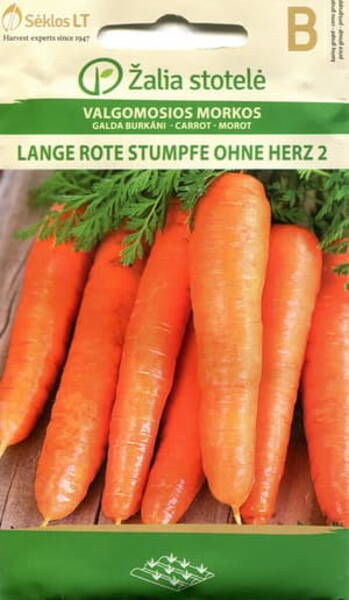Late, very fertile variety. Harvested in 120-130 days after germination of seeds. Root crops are long, cylinder, bright orange. Carrots of this variety are used for juice, they stay well over winter. Grow best in well grown, hummus rich, not soggy loamy or sandy loam soil. If soil is heavy, germination is poor, roots are short, branched, cracked.
1 gram = 850 seeds.
* Winter sowing.
To get a crop of vegetables in early spring, in late April - early May, they need to be sown in the fall. Before winter, it is recommended to sow carrots, radishes, parsnips, lettuce, watercress, Beijing cabbage, spinach, parsley, garlic, onions (seeds and selection per feather).
ADVANTAGES OF WINTER SOWING.
In early spring, it is difficult to work the soil for early sowing of seeds. If, on the contrary, the weather is dry, then the moisture quickly evaporates from the soil surface, and the outcomes will not be friendly. When sowing in late autumn, such difficulties, as a rule, do not arise. Seeds sown at the end of autumn swell during winter thaws, harden under the influence of low temperatures. Plants sown before winter better withstand spring frosts, their root system is more branched, therefore, they better use soil moisture and nutrients. In addition, they are less affected by pests and diseases than plants sown in the spring.
SOIL PREPARATION.
For winter sowing, well-lit areas protected from the winds are taken away. It is desirable that the soil be light in texture (sandy loam, light loam).
As a fertilizer, it is recommended to apply compost (5-10 kg / m2, and on heavy soils - also sand (10-15 kg / m2). If the soil is dry, then it is abundantly watered and leveled.
The ridges are made 1.2-1.6 m wide, the row spacing is 30-40 cm, this makes it easier to care for the crops, and in the spring it is easy to place tunnel shelters above them.
SOWING SEEDS.
Seeds are sown taking into account that they swell, but do not have time to sprout: in late October - mid-November.
With winter sowing, the seeding rate should be 20-30% higher, for carrots this is approximately 6-8 g / m2, radish - 20-30 g / m2, lettuce and parsnip - 5-9 g / m2, dill - 40- 70 g/m2, spinach - 60-80 g/m2, onion seeds - 10-15 g/m2, parsley - 10-12 g/m2.
Before sowing, furrows are cut with a depth of 4-7 cm, the seeds are sown to a depth of 1.5-2.5 cm.
It is recommended to add lettuce or radish seeds (beacon crops) to the seeds of carrots and parsnips, so that in early spring, when tilling the soil between the rows, crops will not be damaged, since these crops germinate later than lettuce and radish.
Crops are mulched with peat to prevent the formation of a crust on the soil surface, covered with spruce branches.
If at the beginning of spring the crops are covered with polyethylene, then you can get an ultra-early harvest of vegetables. At the same time, as with spring sowing, high agricultural technology is important - loosening, top dressing and weed control.
Eng.: Carrot. Suom.: Porkkana. Sven.: Morot. Bot.: Daucus carota L.











